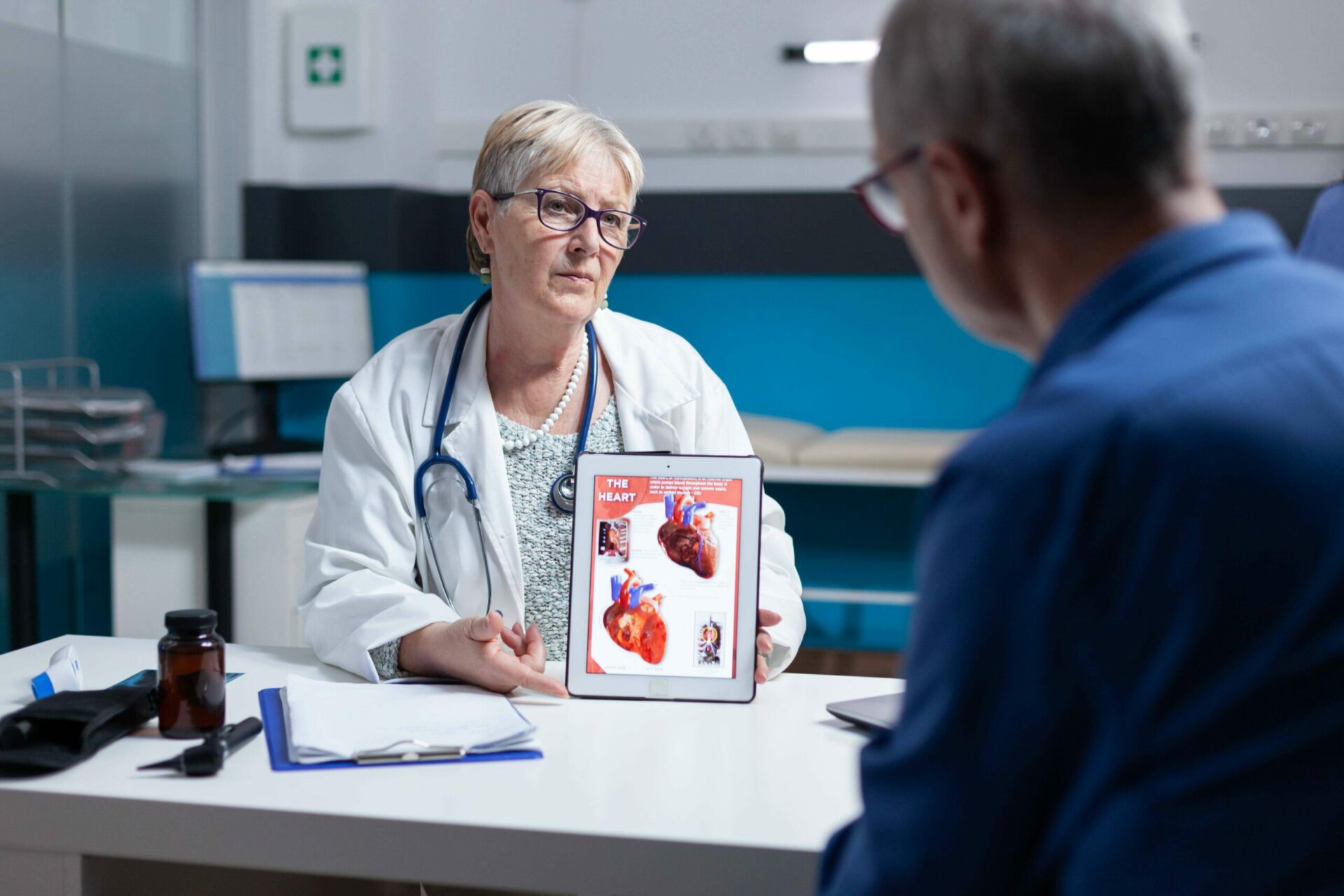We offer a number of various programs and services, but most of the time your care journey will begin with heart tests. These tests help us understand your condition and explain why you are experiencing symptoms such as shortness of breath or chest pain. Once we have been able to diagnose your condition, we offer a number of interventions, as well as typical surgical procedures to help improve your quality of life.

“Lower Bucks Hospital focuses on improving quality of life and longevity for each one of our patients with heart failure”
At Lower Bucks Hospital we focus on medication management and preventive measures, heart failure interventions may include:
- Diagnostic cardiac catheterization
- Percutaneous coronary intervention (PCI), or stenting
Heart failure is a lifelong condition that requires long-term care. Our goal is to effectively manage your symptoms and dramatically reduce the rate of hospitalization and readmission associated with your disease.
Preventive Care
Leading the way in preventive care, Dr. Shahzad Ahmed is focused on helping patients identify risk factors for cardiovascular diseases and prevent the development of serious conditions. He is board certified in Cardiovascular Disease, Internal Medicine, and Interventional Cardiology Cardiac. With these medical backgrounds, he can provide preventive cardiology, non-invasive treatments, and insight on cardiovascular disease.
To schedule an appointment with a Lower Bucks Hospital Heart specialist Dr. Shahzad Ahmed, call 215-785-5100, or visit Find a Provider. To schedule an appointment with any of Lower Bucks Hospital Heart specialists, call 215-785-9343 or 215-785-9690 for questions.

Cardiology Catheterization Lab
The cardiovascular lab is located on the first floor at Lower Bucks Hospital. In this area, routine cardiac catheterization procedures are performed. This is when a catheter is placed in an artery in your hip or arm and threaded through to your heart to look at the blood supply to your heart and how your heart is functioning. The lab also performs balloon angioplasty or stent procedures to “open up” blocked arteries supplying blood to the heart as well as other catheterization procedures that are used for diagnostic or therapeutic reasons. Other staff working in the cardiovascular lab include specially-trained nurses, medical radiation technologists, cardiovascular technologists, and cardiologists. The medical radiation technologists in this lab will primarily monitor the use and movement of the sophisticated x-ray equipment. Heart catheterization allows diagnostic imaging and minor heart procedures A catheter is a thin, flexible tube that is used to access the heart. The tube is inserted into a vein, most commonly in your arm, leg or neck, and is moved up through an artery (large vein) into your heart. From there your doctor is able to make assessments of the heart, identify problems, and conduct certain procedures.
Cardiac Catheterization, May be Used for:
- Angiography – an imaging procedure that allows the doctor to see high-quality photos of the heart and coronary arteries
- Biopsies – a procedure to obtain a tissue sample from the heart to examine it under a microscope for heart disease
- Coronary angioplasty and stenting – a procedure involving a balloon that helps widen the arteries and restore blood flow; stents keep the arteries from closing or collapsing again
A heart catheterization also allows the doctor to check the pressure of the four chambers of the heart, check the function of the heart, and check for atherosclerosis (hardening of the arteries). Cardiac catheterization usually takes place in a hospital setting. It is not a painful procedure though you may experience some aching or pain in the vein after the catheter is removed. You will be awake throughout the process, but you will receive medication to help you relax. Your doctor will discuss everything with you in advance. Depending on the results of your catheterization, your doctor may advise additional treatments or in some cases may recommend surgery as the next step.
Conditions and Treatments
The Cardiac Care program at Lower Bucks Hospital specialized care for patients in suburbs of Philadelphia who have been diagnosed with conditions of the heart and blood vessels. This care includes a number of specialized treatments and procedures for a range of conditions.
Conditions

Atrial Fibrillation
This a very common type of irregular or uneven heartbeat. When you experience an episode of atrial fibrillation your heart will often beat too fast. While many people do not realize they have AFib, others describe feeling fluttering or palpitations in their chest. Atrial fibrillation rarely requires urgent medical care and many people live healthy, normal lives.

Acute Coronary Syndrome
Term that is used to describe a heart attack and sometimes unstable chest pain. A heart attack happens when the blood flow to your heart is interrupted or restricted by a buildup of cholesterol in your coronary arteries. There are two types of heart attack, and your length of stay and what happens while you are in hospital will be determined by the type of heart attack you experience.
Heart Failure
A condition where the heart muscle is weakened and not able to pump blood effectively. Heart failure does not mean that your heart has stopped pumping, it simply means that the heart muscle is weak and not able to keep up with your body’s demands.
Treatments and Procedures

Cardiac Catheterization
A procedure we use to diagnose and treat heart conditions. During this procedure, a thin tube is threaded through your blood vessels into the right or left side your heart. This allows your doctor to do diagnostic tests or provide you with certain treatments.

Cardioversion
A procedure that may be offered to you when you experience an abnormally fast heart beat that makes you feel tired and unwell. Conditions such as atrial fibrillation and atrial flutter may be the reason why you have been referred to Lower Bucks Hospital to have a cardioversion procedure.

Permanent Pacemakers
A pacemaker is a small device (about the size of a wrist watch) that is implanted under the skin in your chest. A pacemaker may be used if your doctor has determined that your heart may beat too slowly or if it has the potential to slow down occasionally.
Cardiac Diagnostic Testing
Heart tests are the many different tools that we use to figure out what might be causing your symptoms. The nature of your symptoms will also help us determine which tests to run. Heart tests are done in the Diagnostic Imagining Department located on the ground floor at Lower Bucks Hospital. The easiest way to find Diagnostic Imaging is through the hospital’s main entrance off Bristol Road. Security at the main desk will be able to help you find your way.
Angiogram
In this procedure a small catheter is inserted into your wrist or groin then with the guidance of X-ray the catheter is moved to the arteries of the heart. A dye is injected to make help make your arteries easier to see. This test helps your doctor determine if there are any blockages in your heart. You may be asked to stop taking certain medications or begin taking certain medications before the procedure. Most people can have a light meal before this test.
Carotid Dopplers
This is an ultrasound that shows blood flow through the arteries in the neck, no special preparation is required for this test.
Computed Tomography Scan (CT Scan)
Also known as a CAT scan are unlike conventional X-Ray images. The images appear as slices, like slices in a loaf of bread. An X-ray technologist, who has had special training in CT scanning, will perform your scan. The images are then read and reported on by a radiologist, who is a doctor with specialized training in computerized tomography.
Chest X-ray (CXR)
A chest X-ray is a picture of the chest that shows your heart, lungs, airway, blood vessels and lymph nodes. A chest X-ray also shows the bones of your spine and chest, including your breastbone, ribs, collarbone, as well as the upper part of your spine.
Echocardiogram (ECHO), Transthoracic (TTE), Transesophageal (TEE)
These are ultrasound tests that are used to that look at your heart muscle function and heart valves:
- In a Transthoracic ECHO, a cold jelly is placed on the surface of your chest then a wand is rubbed across your chest to produce images of your heart. This is a non-invasive test and no special preparation is required.
- During the Transesophageal ECHO you will receive some medication to help you relax as a tube is placed into your mouth and down into your throat. This will allow us to see your heart muscle and valves more clearly. You will be asked to not eat before this test. You will need someone to drive you home after it is complete.
Epinephrine or Procainamide Challenge Tests
To help us determine if you have a heart rhythm problem, also known as an arrhythmia, we may perform an Epinephrine or Procainamide Challenge. This is a test that looks at the electrical system of your heart and is done on an outpatient basis.
Myocardial Perfusion Study (MIBI)
This test looks at the health of your heart arteries and muscle. MIBI is a name for the radioactive tracer given to you through an IV line. You will have two scans as part of this exam, one after the dye is inserted, while you are resting. The second few hours later after you have exercised. If you are unable to exercise, you may be given medication instead.
Stress Test
You will be asked to exercise on a treadmill or bicycle and at the same time an electrical tracing of your heart will be performed by ECG, see above. This test will look for changes in your ECG. No special preparation is required for this test, however you should wear comfortable shoes.
Stress ECHO
Similar to the stress test above, however an ultrasound of your heart is performed to look for abnormalities in your heart’s muscle function. An abnormality may indicate a heart problem. If you are not able to exercise for this test, your health-care team may suggest the use of a medication to make your heart act like it is exercising.
Magnetic Resonance Imaging (MRI)
Magnetic resonance imaging (MRI) is a technique that uses a magnetic field and radio waves to create detailed images of the organs and tissues within your body. Most MRI machines are large, tube-shaped magnets.
Featured Services

Cardiology

Orthopedics

Surgical Services

Careers

Diagnostic Imaging



